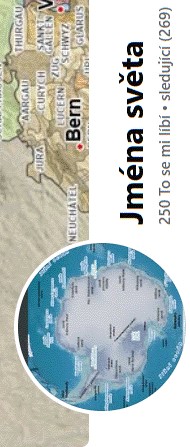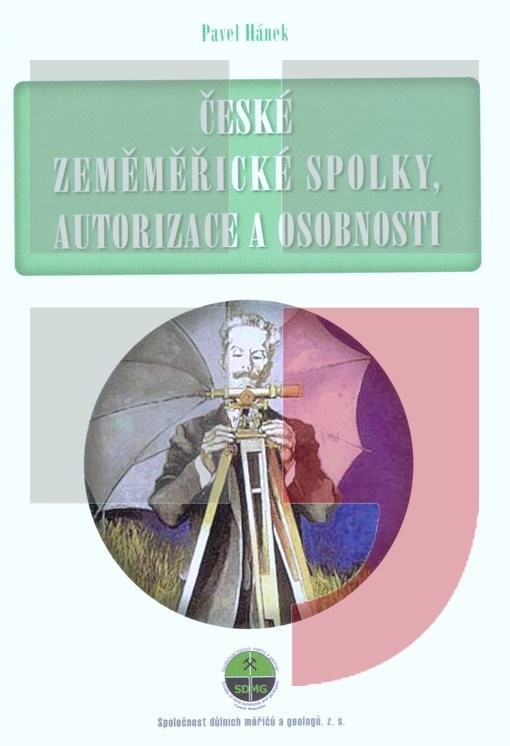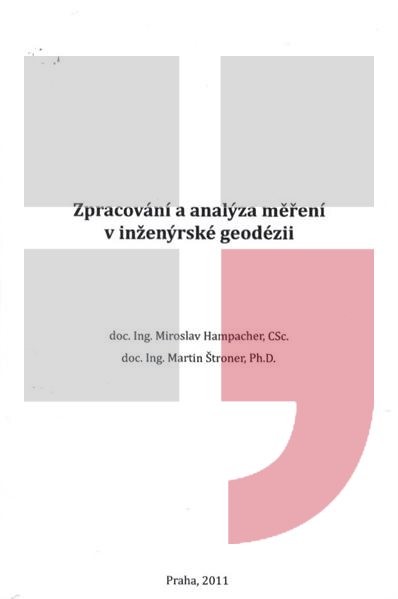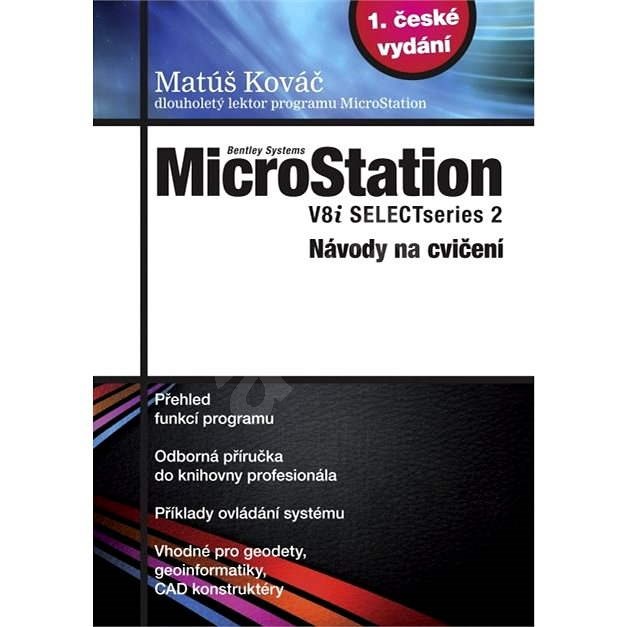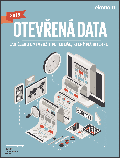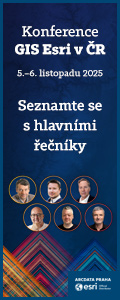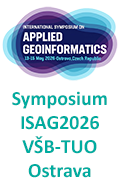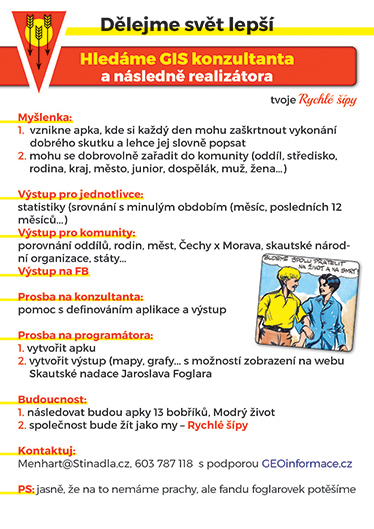zprávy
zdroje zpráv:Rada/odborný rada-vedoucí oddělení dokumentace katastru nemovitostí
16.5.2016 11:46 ČÚZK - předpisy a opatření Katastrální úřad pro Liberecký kraj Katastrální pracoviště Semilyvypisuje výberové rízení na místo
Rada/odborný rada-vedoucí oddělení dokumentace katastru nemovitostí
Oznámení o vyhlášení výběrového řízení
16.5.2016 11:39 ČÚZK /Urady/Katastralni-urady/Katastralni-urady/Katastralni-urad-pro-Karlovarsky-kraj/Katastralni-pracoviste/KP-Sokolov/O-uradu/Aktuality/Oznameni-o-vyhlaseni-vyberoveho-rizeniOznámení o vyhlášení výběrového řízení
16.5.2016 11:39 ČÚZK - předpisy a opatření Oznámení o vyhlášení výběrového řízení na služební místoodborný referent – oddělení dokumentace katastru nemovitostí
Katastrální pracoviště Sokolov, Katastrální úřad pro Karlovarský kraj
Dokument: ZDE
Oznámení o vyhlášení výběrového řízení
16.5.2016 11:39 ČÚZK - předpisy a opatření Oznámení o vyhlášení výběrového řízení na služební místoodborný referent – oddělení dokumentace katastru nemovitostí
Katastrální pracoviště Sokolov, Katastrální úřad pro Karlovarský kraj
Dokument: ZDE
Oznámení o vyhlášení výběrového řízení
16.5.2016 11:39 ČÚZK - předpisy a opatření Oznámení o vyhlášení výběrového řízení na služební místoodborný referent – oddělení dokumentace katastru nemovitostí
Katastrální pracoviště Sokolov, Katastrální úřad pro Karlovarský kraj
Dokument: ZDE
Oznámení o vyhlášení výběrového řízení
16.5.2016 11:39 ČÚZK - předpisy a opatření Oznámení o vyhlášení výběrového řízení na služební místoodborný referent – oddělení dokumentace katastru nemovitostí
Katastrální pracoviště Sokolov, Katastrální úřad pro Karlovarský kraj
Dokument: ZDE
Oznámení o vyhlášení výběrového řízení
16.5.2016 11:39 ČÚZK - předpisy a opatření Oznámení o vyhlášení výběrového řízení na služební místoodborný referent – oddělení dokumentace katastru nemovitostí
Katastrální pracoviště Sokolov, Katastrální úřad pro Karlovarský kraj
Dokument: ZDE
Oznámení o vyhlášení výběrového řízení
16.5.2016 11:39 ČÚZK - předpisy a opatření Oznámení o vyhlášení výběrového řízení na služební místoodborný referent – oddělení dokumentace katastru nemovitostí
Katastrální pracoviště Sokolov, Katastrální úřad pro Karlovarský kraj
Dokument: ZDE
odborný referent - poskytování informací KN a PK, poskytování podkladů, nahlížení do KN
16.5.2016 10:52 ČÚZK - předpisy a opatření Katastrální úřad pro Olomoucký kraj Katastrální pracoviště Jeseník vypisuje výberové rízení na místo odborný referent - poskytování informací KN a PK, poskytování podkladů, nahlížení do KNodborný referent - poskytování informací KN a PK, poskytování podkladů, nahlížení do KN
16.5.2016 10:52 ČÚZK - volná místa Katastrální úřad pro Olomoucký kraj, Katastrální pracoviště Jeseníkodborný referent - poskytování informací KN a PK, poskytování podkladů, nahlížení do KN
16.5.2016 10:52 ČÚZK /Urady/Katastralni-urady/Katastralni-urady/Katastralni-urad-pro-Olomoucky-kraj/Uredni-deska/Oznameni-a-jina-uredni-sdeleni/Volna-mista/odborny-referent-poskytovani-informaci-KN-a-PK,-poodborný referent - poskytování informací KN a PK, poskytování podkladů, nahlížení do KN
16.5.2016 10:52 ČÚZK - předpisy a opatření Katastrální úřad pro Olomoucký kraj Katastrální pracoviště Jeseníkvypisuje výberové rízení na místo
odborný referent - poskytování informací KN a PK, poskytování podkladů, nahlížení do KN
odborný referent - poskytování informací KN a PK, poskytování podkladů, nahlížení do KN
16.5.2016 10:52 ČÚZK - předpisy a opatření Katastrální úřad pro Olomoucký kraj Katastrální pracoviště Jeseníkodborný referent - poskytování informací KN a PK, poskytování podkladů, nahlížení do KN
16.5.2016 10:52 ČÚZK - volná místa Katastrální úřad pro Olomoucký kraj, Katastrální pracoviště Jeseník vypisuje výběrové řízení na místo odborný referent - poskytování informací KN a PK, poskytování podkladů, nahlížení do KNodborný referent - poskytování informací KN a PK, poskytování podkladů, nahlížení do KN
16.5.2016 10:52 ČÚZK - předpisy a opatření Katastrální úřad pro Olomoucký kraj Katastrální pracoviště Jeseník vypisuje výberové rízení na místo odborný referent - poskytování informací KN a PK, poskytování podkladů, nahlížení do KNodborný referent - poskytování informací KN a PK, poskytování podkladů, nahlížení do KN
16.5.2016 10:52 ČÚZK - předpisy a opatření Katastrální úřad pro Olomoucký kraj Katastrální pracoviště Jeseník vypisuje výberové rízení na místo odborný referent - poskytování informací KN a PK, poskytování podkladů, nahlížení do KNodborný referent - poskytování informací KN a PK, poskytování podkladů, nahlížení do KN
16.5.2016 10:52 ČÚZK - předpisy a opatření Katastrální úřad pro Olomoucký kraj Katastrální pracoviště Jeseníkvypisuje výberové rízení na místo
odborný referent - poskytování informací KN a PK, poskytování podkladů, nahlížení do KN
Odborný rada-vedoucí oddělení právních vztahů
16.5.2016 10:44 ČÚZK - volná místa Katastrální úřad pro Liberecký kraj, Katastrální pracoviště Semily vypisuje výběrové řízení na místo Odborný rada-vedoucí oddělení právních vztahůOdborný rada-vedoucí oddělení právních vztahů
16.5.2016 10:44 ČÚZK - předpisy a opatření Katastrální úřad pro Liberecký kraj Katastrální pracoviště Semily vypisuje výberové rízení na místo Odborný rada-vedoucí oddělení právních vztahůOdborný rada-vedoucí oddělení právních vztahů
16.5.2016 10:44 ČÚZK - předpisy a opatření Katastrální úřad pro Liberecký kraj Katastrální pracoviště Semily vypisuje výberové rízení na místo Odborný rada-vedoucí oddělení právních vztahůOdborný rada-vedoucí oddělení právních vztahů
16.5.2016 10:44 ČÚZK /Urady/Katastralni-urady/Katastralni-urady/Katastralni-urad-pro-Liberecky-kraj/Uredni-deska/Oznameni-a-jina-uredni-sdeleni/Volna-mista/Odborny-rada-vedouci-oddeleni-pravnich-vztahu-(1)Odborný rada-vedoucí oddělení právních vztahů
16.5.2016 10:44 ČÚZK - předpisy a opatření Katastrální úřad pro Liberecký kraj Katastrální pracoviště SemilyOdborný rada-vedoucí oddělení právních vztahů
16.5.2016 10:44 ČÚZK - předpisy a opatření Katastrální úřad pro Liberecký kraj Katastrální pracoviště Semily vypisuje výberové rízení na místo Odborný rada-vedoucí oddělení právních vztahůOdborný rada-vedoucí oddělení právních vztahů
16.5.2016 10:44 ČÚZK - předpisy a opatření Katastrální úřad pro Liberecký kraj Katastrální pracoviště Semilyvypisuje výberové rízení na místo
Odborný rada-vedoucí oddělení právních vztahů
Odborný rada-vedoucí oddělení právních vztahů
16.5.2016 10:44 ČÚZK - volná místa Katastrální úřad pro Liberecký kraj, Katastrální pracoviště SemilyOdborný rada-vedoucí oddělení právních vztahů
16.5.2016 10:44 ČÚZK - předpisy a opatření Katastrální úřad pro Liberecký kraj Katastrální pracoviště Semilyvypisuje výberové rízení na místo
Odborný rada-vedoucí oddělení právních vztahů
Odborný rada-vedoucí oddělení právních vztahů
16.5.2016 10:25 ČÚZK - předpisy a opatření Katastrální úřad pro Liberecký kraj Katastrální pracoviště Jablonec nad Nisou vypisuje výberové rízení na místo Odborný rada-vedoucí oddělení právních vztahůOdborný rada-vedoucí oddělení právních vztahů
16.5.2016 10:25 ČÚZK /Urady/Katastralni-urady/Katastralni-urady/Katastralni-urad-pro-Liberecky-kraj/Uredni-deska/Oznameni-a-jina-uredni-sdeleni/Volna-mista/Odborny-rada-vedouci-oddeleni-pravnich-vztahuOdborný rada-vedoucí oddělení právních vztahů
16.5.2016 10:25 ČÚZK - předpisy a opatření Katastrální úřad pro Liberecký kraj Katastrální pracoviště Jablonec nad Nisouvypisuje výberové rízení na místo
Odborný rada-vedoucí oddělení právních vztahů
Odborný rada-vedoucí oddělení právních vztahů
16.5.2016 10:25 ČÚZK - předpisy a opatření Katastrální úřad pro Liberecký kraj Katastrální pracoviště Jablonec nad Nisou vypisuje výberové rízení na místo Odborný rada-vedoucí oddělení právních vztahůOdborný rada-vedoucí oddělení právních vztahů
16.5.2016 10:25 ČÚZK - předpisy a opatření Katastrální úřad pro Liberecký kraj Katastrální pracoviště Jablonec nad NisouOdborný rada-vedoucí oddělení právních vztahů
16.5.2016 10:25 ČÚZK - volná místa Katastrální úřad pro Liberecký kraj, Katastrální pracoviště Jablonec nad Nisou vypisuje výběrové řízení na místo Odborný rada-vedoucí oddělení právních vztahůOdborný rada-vedoucí oddělení právních vztahů
16.5.2016 10:25 ČÚZK - předpisy a opatření Katastrální úřad pro Liberecký kraj Katastrální pracoviště Jablonec nad Nisouvypisuje výberové rízení na místo
Odborný rada-vedoucí oddělení právních vztahů
Odborný rada-vedoucí oddělení právních vztahů
16.5.2016 10:25 ČÚZK - volná místa Katastrální úřad pro Liberecký kraj, Katastrální pracoviště Jablonec nad NisouOdborný rada-vedoucí oddělení aktualizace
16.5.2016 10:11 ČÚZK - volná místa Katastrální úřad pro Liberecký kraj, Katastrální pracoviště Jablonec nad NisouOdborný rada-vedoucí oddělení aktualizace
16.5.2016 10:11 ČÚZK - předpisy a opatření Katastrální úřad pro Liberecký kraj Katastrální pracoviště Jablonec nad Nisouvypisuje výberové rízení na místo
Odborný rada-vedoucí oddělení aktualizace
Odborný rada-vedoucí oddělení aktualizace
16.5.2016 10:11 ČÚZK - předpisy a opatření Katastrální úřad pro Liberecký kraj Katastrální pracoviště Jablonec nad Nisou vypisuje výberové rízení na místo Odborný rada-vedoucí oddělení aktualizaceOdborný rada-vedoucí oddělení aktualizace
16.5.2016 10:11 ČÚZK - předpisy a opatření Katastrální úřad pro Liberecký kraj Katastrální pracoviště Jablonec nad NisouOdborný rada-vedoucí oddělení aktualizace
16.5.2016 10:11 ČÚZK - předpisy a opatření Katastrální úřad pro Liberecký kraj Katastrální pracoviště Jablonec nad Nisou vypisuje výberové rízení na místo Odborný rada-vedoucí oddělení aktualizaceOdborný rada-vedoucí oddělení aktualizace
16.5.2016 10:11 ČÚZK - volná místa Katastrální úřad pro Liberecký kraj, Katastrální pracoviště Jablonec nad Nisou vypisuje výběrové řízení na místo Odborný rada-vedoucí oddělení aktualizaceOdborný rada-vedoucí oddělení aktualizace
16.5.2016 10:11 ČÚZK - předpisy a opatření Katastrální úřad pro Liberecký kraj Katastrální pracoviště Jablonec nad Nisouvypisuje výberové rízení na místo
Odborný rada-vedoucí oddělení aktualizace
Odborný rada-vedoucí oddělení aktualizace
16.5.2016 10:11 ČÚZK /Urady/Katastralni-urady/Katastralni-urady/Katastralni-urad-pro-Liberecky-kraj/Uredni-deska/Oznameni-a-jina-uredni-sdeleni/Volna-mista/Odborny-rada-vedouci-oddeleni-aktualizaceMapa roku 2015
16.5.2016 9:50 ARCDATAČeská kartografická společnost vybírala nejlepší díla roku již po osmnácté. Odborná komise opět hodnotila několik kategorií včetně Digitálních kartografických produktů a aplikací na internetu, kde zvítězila aplikace Analýzy výškopisu.
Díky této aplikaci, která vznikla na Českém úřadu zeměměřickém a katastrálním, můžete prohlížet výškopisná data odvozená z digitálního modelu terénu a digitálního modelu povrchu vzniklých leteckým laserovým skenováním. Jejím prostřednictvím je možné znázornit sklonitost a orientaci svahů, stínovaný a obarvený reliéf, a to i včetně Z-faktoru 10.
Podrobné informace o aplikaci a používaných službách si můžete přečíst ve článku v časopisu ArcRevue 3/2015.
Vedoucí oddělení dokumentace katastru nemovitostí Katastrálního pracoviště Teplice na Katastrálním ú
16.5.2016 9:20 ČÚZK - předpisy a opatření Katastrální úřad pro Ústecký kraj Katastrální pracoviště Teplice vypisuje výberové rízení na místo Vedoucí oddělení dokumentace katastru nemovitostí Katastrálního pracoviště Teplice na Katastrálním úřadu pro Ústecký krajVedoucí oddělení dokumentace katastru nemovitostí Katastrálního pracoviště Teplice na Katastrálním ú
16.5.2016 9:20 ČÚZK - předpisy a opatření Katastrální úřad pro Ústecký kraj Katastrální pracoviště Teplice vypisuje výberové rízení na místo Vedoucí oddělení dokumentace katastru nemovitostí Katastrálního pracoviště Teplice na Katastrálním úřadu pro Ústecký krajVedoucí oddělení dokumentace katastru nemovitostí Katastrálního pracoviště Teplice na Katastrálním ú
16.5.2016 9:20 ČÚZK /Urady/Katastralni-urady/Katastralni-urady/Katastralni-urad-pro-Ustecky-kraj/Uredni-deska/Oznameni-a-jina-uredni-sdeleni/Volna-mista/Vedouci-oddeleni-dokumentace-katastru-nemovitostiVedoucí oddělení dokumentace katastru nemovitostí Katastrálního pracoviště Teplice na Katastrálním ú
16.5.2016 9:20 ČÚZK - předpisy a opatření Katastrální úřad pro Ústecký kraj Katastrální pracoviště Teplicevypisuje výberové rízení na místo
Vedoucí oddělení dokumentace katastru nemovitostí Katastrálního pracoviště Teplice na Katastrálním úřadu pro Ústecký kraj
Vedoucí oddělení dokumentace katastru nemovitostí Katastrálního pracoviště Teplice na Katastrálním ú
16.5.2016 9:20 ČÚZK - předpisy a opatření Katastrální úřad pro Ústecký kraj Katastrální pracoviště Teplice vypisuje výberové rízení na místo Vedoucí oddělení dokumentace katastru nemovitostí Katastrálního pracoviště Teplice na Katastrálním úřadu pro Ústecký krajVedoucí oddělení dokumentace katastru nemovitostí Katastrálního pracoviště Teplice na Katastrálním ú
16.5.2016 9:20 ČÚZK - volná místa Katastrální úřad pro Ústecký kraj, Katastrální pracoviště TepliceVedoucí oddělení dokumentace katastru nemovitostí Katastrálního pracoviště Teplice na Katastrálním ú
16.5.2016 9:20 ČÚZK - předpisy a opatření Katastrální úřad pro Ústecký kraj Katastrální pracoviště TepliceVedoucí oddělení dokumentace katastru nemovitostí Katastrálního pracoviště Teplice na Katastrálním ú
16.5.2016 9:20 ČÚZK - volná místa Katastrální úřad pro Ústecký kraj, Katastrální pracoviště Teplice vypisuje výběrové řízení na místo Vedoucí oddělení dokumentace katastru nemovitostí Katastrálního pracoviště Teplice na Katastrálním úVedoucí oddělení aktualizace katastru nemovitostí Katastrálního pracoviště Teplice na Katastrálním ú
16.5.2016 9:18 ČÚZK - předpisy a opatření Katastrální úřad pro Ústecký kraj Katastrální pracoviště Teplice vypisuje výberové rízení na místo Vedoucí oddělení aktualizace katastru nemovitostí Katastrálního pracoviště Teplice na Katastrálním úřadu pro Ústecký krajVedoucí oddělení aktualizace katastru nemovitostí Katastrálního pracoviště Teplice na Katastrálním ú
16.5.2016 9:18 ČÚZK - předpisy a opatření Katastrální úřad pro Ústecký kraj Katastrální pracoviště Teplice vypisuje výberové rízení na místo Vedoucí oddělení aktualizace katastru nemovitostí Katastrálního pracoviště Teplice na Katastrálním úřadu pro Ústecký krajVedoucí oddělení aktualizace katastru nemovitostí Katastrálního pracoviště Teplice na Katastrálním ú
16.5.2016 9:18 ČÚZK - volná místa Katastrální úřad pro Ústecký kraj, Katastrální pracoviště TepliceVedoucí oddělení aktualizace katastru nemovitostí Katastrálního pracoviště Teplice na Katastrálním ú
16.5.2016 9:18 ČÚZK /Urady/Katastralni-urady/Katastralni-urady/Katastralni-urad-pro-Ustecky-kraj/Uredni-deska/Oznameni-a-jina-uredni-sdeleni/Volna-mista/Vedouci-oddeleni-aktualizace-katastru-nemovitostiVedoucí oddělení aktualizace katastru nemovitostí Katastrálního pracoviště Teplice na Katastrálním ú
16.5.2016 9:18 ČÚZK - volná místa Katastrální úřad pro Ústecký kraj, Katastrální pracoviště Teplice vypisuje výběrové řízení na místo Vedoucí oddělení aktualizace katastru nemovitostí Katastrálního pracoviště Teplice na Katastrálním úVedoucí oddělení aktualizace katastru nemovitostí Katastrálního pracoviště Teplice na Katastrálním ú
16.5.2016 9:18 ČÚZK - předpisy a opatření Katastrální úřad pro Ústecký kraj Katastrální pracoviště Teplicevypisuje výberové rízení na místo
Vedoucí oddělení aktualizace katastru nemovitostí Katastrálního pracoviště Teplice na Katastrálním úřadu pro Ústecký kraj
Vedoucí oddělení aktualizace katastru nemovitostí Katastrálního pracoviště Teplice na Katastrálním ú
16.5.2016 9:18 ČÚZK - předpisy a opatření Katastrální úřad pro Ústecký kraj Katastrální pracoviště Teplicevypisuje výberové rízení na místo
Vedoucí oddělení aktualizace katastru nemovitostí Katastrálního pracoviště Teplice na Katastrálním úřadu pro Ústecký kraj
Vedoucí oddělení aktualizace katastru nemovitostí Katastrálního pracoviště Teplice na Katastrálním ú
16.5.2016 9:18 ČÚZK - předpisy a opatření Katastrální úřad pro Ústecký kraj Katastrální pracoviště TepliceVedoucí oddělení právních vztahů k nemovitostem Katastrálního pracoviště Teplice na Katastrálním úřa
16.5.2016 9:17 ČÚZK - předpisy a opatření Katastrální úřad pro Ústecký kraj Katastrální pracoviště Teplicevypisuje výberové rízení na místo
Vedoucí oddělení právních vztahů k nemovitostem Katastrálního pracoviště Teplice na Katastrálním úřadu pro Ústecký kraj
Vedoucí oddělení právních vztahů k nemovitostem Katastrálního pracoviště Teplice na Katastrálním úřa
16.5.2016 9:17 ČÚZK - předpisy a opatření Katastrální úřad pro Ústecký kraj Katastrální pracoviště TepliceVedoucí oddělení právních vztahů k nemovitostem Katastrálního pracoviště Teplice na Katastrálním úřa
16.5.2016 9:17 ČÚZK - předpisy a opatření Katastrální úřad pro Ústecký kraj Katastrální pracoviště Teplice vypisuje výberové rízení na místo Vedoucí oddělení právních vztahů k nemovitostem Katastrálního pracoviště Teplice na Katastrálním úřadu pro Ústecký krajVedoucí oddělení právních vztahů k nemovitostem Katastrálního pracoviště Teplice na Katastrálním úřa
16.5.2016 9:17 ČÚZK /Urady/Katastralni-urady/Katastralni-urady/Katastralni-urad-pro-Ustecky-kraj/Uredni-deska/Oznameni-a-jina-uredni-sdeleni/Volna-mista/Vedouci-oddeleni-pravnich-vztahu-k-nemovitoste-(2)Vedoucí oddělení právních vztahů k nemovitostem Katastrálního pracoviště Teplice na Katastrálním úřa
16.5.2016 9:17 ČÚZK - volná místa Katastrální úřad pro Ústecký kraj, Katastrální pracoviště TepliceVedoucí oddělení právních vztahů k nemovitostem Katastrálního pracoviště Teplice na Katastrálním úřa
16.5.2016 9:17 ČÚZK - předpisy a opatření Katastrální úřad pro Ústecký kraj Katastrální pracoviště Teplice vypisuje výberové rízení na místo Vedoucí oddělení právních vztahů k nemovitostem Katastrálního pracoviště Teplice na Katastrálním úřadu pro Ústecký krajVedoucí oddělení právních vztahů k nemovitostem Katastrálního pracoviště Teplice na Katastrálním úřa
16.5.2016 9:17 ČÚZK - předpisy a opatření Katastrální úřad pro Ústecký kraj Katastrální pracoviště Teplice vypisuje výberové rízení na místo Vedoucí oddělení právních vztahů k nemovitostem Katastrálního pracoviště Teplice na Katastrálním úřadu pro Ústecký krajVedoucí oddělení právních vztahů k nemovitostem Katastrálního pracoviště Teplice na Katastrálním úřa
16.5.2016 9:17 ČÚZK - volná místa Katastrální úřad pro Ústecký kraj, Katastrální pracoviště Teplice vypisuje výběrové řízení na místo Vedoucí oddělení právních vztahů k nemovitostem Katastrálního pracoviště Teplice na Katastrálním úřaVedoucí oddělení právních vztahů k nemovitostem Katastrálního pracoviště Teplice na Katastrálním úřa
16.5.2016 9:17 ČÚZK - předpisy a opatření Katastrální úřad pro Ústecký kraj Katastrální pracoviště Teplicevypisuje výberové rízení na místo
Vedoucí oddělení právních vztahů k nemovitostem Katastrálního pracoviště Teplice na Katastrálním úřadu pro Ústecký kraj
Vedoucí oddělení právních vztahů k nemovitostem Katastrálního pracoviště Ústí nad Labem na Katastrál
16.5.2016 9:15 ČÚZK - předpisy a opatření Katastrální úřad pro Ústecký kraj Katastrální pracoviště Ústí nad Labem vypisuje výberové rízení na místo Vedoucí oddělení právních vztahů k nemovitostem Katastrálního pracoviště Ústí nad Labem na Katastrálním úřadu pro Ústecký krajVedoucí oddělení právních vztahů k nemovitostem Katastrálního pracoviště Ústí nad Labem na Katastrál
16.5.2016 9:15 ČÚZK - volná místa Katastrální úřad pro Ústecký kraj, Katastrální pracoviště Ústí nad LabemVedoucí oddělení právních vztahů k nemovitostem Katastrálního pracoviště Ústí nad Labem na Katastrál
16.5.2016 9:15 ČÚZK - předpisy a opatření Katastrální úřad pro Ústecký kraj Katastrální pracoviště Ústí nad Labem vypisuje výberové rízení na místo Vedoucí oddělení právních vztahů k nemovitostem Katastrálního pracoviště Ústí nad Labem na Katastrálním úřadu pro Ústecký krajVedoucí oddělení právních vztahů k nemovitostem Katastrálního pracoviště Ústí nad Labem na Katastrál
16.5.2016 9:15 ČÚZK - předpisy a opatření Katastrální úřad pro Ústecký kraj Katastrální pracoviště Ústí nad Labem vypisuje výberové rízení na místo Vedoucí oddělení právních vztahů k nemovitostem Katastrálního pracoviště Ústí nad Labem na Katastrálním úřadu pro Ústecký krajVedoucí oddělení právních vztahů k nemovitostem Katastrálního pracoviště Ústí nad Labem na Katastrál
16.5.2016 9:15 ČÚZK /Urady/Katastralni-urady/Katastralni-urady/Katastralni-urad-pro-Ustecky-kraj/Uredni-deska/Oznameni-a-jina-uredni-sdeleni/Volna-mista/Vedouci-oddeleni-pravnich-vztahu-k-nemovitoste-(1)Vedoucí oddělení právních vztahů k nemovitostem Katastrálního pracoviště Ústí nad Labem na Katastrál
16.5.2016 9:15 ČÚZK - předpisy a opatření Katastrální úřad pro Ústecký kraj Katastrální pracoviště Ústí nad LabemVedoucí oddělení právních vztahů k nemovitostem Katastrálního pracoviště Ústí nad Labem na Katastrál
16.5.2016 9:15 ČÚZK - předpisy a opatření Katastrální úřad pro Ústecký kraj Katastrální pracoviště Ústí nad Labemvypisuje výberové rízení na místo
Vedoucí oddělení právních vztahů k nemovitostem Katastrálního pracoviště Ústí nad Labem na Katastrálním úřadu pro Ústecký kraj
Vedoucí oddělení právních vztahů k nemovitostem Katastrálního pracoviště Ústí nad Labem na Katastrál
16.5.2016 9:15 ČÚZK - předpisy a opatření Katastrální úřad pro Ústecký kraj Katastrální pracoviště Ústí nad Labemvypisuje výberové rízení na místo
Vedoucí oddělení právních vztahů k nemovitostem Katastrálního pracoviště Ústí nad Labem na Katastrálním úřadu pro Ústecký kraj
Vedoucí oddělení aktualizace a dokumentace katastru nemovitostí Katastrálního pracoviště Ústí nad La
16.5.2016 9:08 ČÚZK - předpisy a opatření Katastrální úřad pro Ústecký kraj Katastrální pracoviště Ústí nad Labem vypisuje výberové rízení na místo Vedoucí oddělení aktualizace a dokumentace katastru nemovitostí Katastrálního pracoviště Ústí nad Labem na Katastrálním úřadu pro Ústecký krajVedoucí oddělení aktualizace a dokumentace katastru nemovitostí Katastrálního pracoviště Ústí nad La
16.5.2016 9:08 ČÚZK /Urady/Katastralni-urady/Katastralni-urady/Katastralni-urad-pro-Ustecky-kraj/Uredni-deska/Oznameni-a-jina-uredni-sdeleni/Volna-mista/Vedouci-oddeleni-aktualizace-a-dokumentace-katastrVedoucí oddělení aktualizace a dokumentace katastru nemovitostí Katastrálního pracoviště Ústí nad La
16.5.2016 9:08 ČÚZK - předpisy a opatření Katastrální úřad pro Ústecký kraj Katastrální pracoviště Ústí nad Labemvypisuje výberové rízení na místo
Vedoucí oddělení aktualizace a dokumentace katastru nemovitostí Katastrálního pracoviště Ústí nad Labem na Katastrálním úřadu pro Ústecký kraj
Vedoucí oddělení aktualizace a dokumentace katastru nemovitostí Katastrálního pracoviště Ústí nad La
16.5.2016 9:08 ČÚZK - předpisy a opatření Katastrální úřad pro Ústecký kraj Katastrální pracoviště Ústí nad Labem vypisuje výberové rízení na místo Vedoucí oddělení aktualizace a dokumentace katastru nemovitostí Katastrálního pracoviště Ústí nad Labem na Katastrálním úřadu pro Ústecký krajVedoucí oddělení aktualizace a dokumentace katastru nemovitostí Katastrálního pracoviště Ústí nad La
16.5.2016 9:08 ČÚZK - předpisy a opatření Katastrální úřad pro Ústecký kraj Katastrální pracoviště Ústí nad Labemvypisuje výberové rízení na místo
Vedoucí oddělení aktualizace a dokumentace katastru nemovitostí Katastrálního pracoviště Ústí nad Labem na Katastrálním úřadu pro Ústecký kraj
Vedoucí oddělení aktualizace a dokumentace katastru nemovitostí Katastrálního pracoviště Ústí nad La
16.5.2016 9:08 ČÚZK - předpisy a opatření Katastrální úřad pro Ústecký kraj Katastrální pracoviště Ústí nad LabemVedoucí oddělení aktualizace a dokumentace katastru nemovitostí Katastrálního pracoviště Ústí nad La
16.5.2016 9:08 ČÚZK - volná místa Katastrální úřad pro Ústecký kraj, Katastrální pracoviště Ústí nad LabemVedoucí oddělení aktualizace a dokumentace katastru nemovitostí Katastrálního pracoviště Ústí nad La
16.5.2016 9:08 ČÚZK - předpisy a opatření Katastrální úřad pro Ústecký kraj Katastrální pracoviště Ústí nad Labem vypisuje výberové rízení na místo Vedoucí oddělení aktualizace a dokumentace katastru nemovitostí Katastrálního pracoviště Ústí nad Labem na Katastrálním úřadu pro Ústecký krajRada/Odborný rada - oddělení aktualizace KN Katastrálního pracoviště Tábor
16.5.2016 8:45 ČÚZK - předpisy a opatření Katastrální úřad pro Jihočeský kraj Katastrální pracoviště Tábor vypisuje výberové rízení na místo Rada/Odborný rada - oddělení aktualizace KN Katastrálního pracoviště TáborRada/Odborný rada - oddělení aktualizace KN Katastrálního pracoviště Tábor
16.5.2016 8:45 ČÚZK /Urady/Katastralni-urady/Katastralni-urady/Katastralni-urad-pro-Jihocesky-kraj/Volna-mista/Rada-Odborny-rada-v-oddeleni-aktualizace-KN-KatastRada/Odborný rada - oddělení aktualizace KN Katastrálního pracoviště Tábor
16.5.2016 8:45 ČÚZK - předpisy a opatření Katastrální úřad pro Jihočeský kraj Katastrální pracoviště Táborvypisuje výberové rízení na místo
Rada/Odborný rada - oddělení aktualizace KN Katastrálního pracoviště Tábor
Rada/Odborný rada - oddělení aktualizace KN Katastrálního pracoviště Tábor
16.5.2016 8:45 ČÚZK - předpisy a opatření Katastrální úřad pro Jihočeský kraj Katastrální pracoviště Tábor vypisuje výberové rízení na místo Rada/Odborný rada - oddělení aktualizace KN Katastrálního pracoviště TáborRada/Odborný rada - oddělení aktualizace KN Katastrálního pracoviště Tábor
16.5.2016 8:45 ČÚZK - předpisy a opatření Katastrální úřad pro Jihočeský kraj Katastrální pracoviště Tábor vypisuje výberové rízení na místo Rada/Odborný rada - oddělení aktualizace KN Katastrálního pracoviště TáborRada/Odborný rada - oddělení aktualizace KN Katastrálního pracoviště Tábor
16.5.2016 8:45 ČÚZK - předpisy a opatření Katastrální úřad pro Jihočeský kraj Katastrální pracoviště TáborRada/Odborný rada - oddělení aktualizace KN Katastrálního pracoviště Tábor
16.5.2016 8:45 ČÚZK - volná místa Katastrální úřad pro Jihočeský kraj, Katastrální pracoviště TáborRada/Odborný rada - oddělení aktualizace KN Katastrálního pracoviště Tábor
16.5.2016 8:45 ČÚZK - předpisy a opatření Katastrální úřad pro Jihočeský kraj Katastrální pracoviště Táborvypisuje výberové rízení na místo
Rada/Odborný rada - oddělení aktualizace KN Katastrálního pracoviště Tábor
výpadek WAN
16.5.2016 8:27 ČÚZK /Urady/Katastralni-urady/Katastralni-urady/Katastralni-urad-pro-Kralovehradecky-kraj/Katastralni-pracoviste/KP-Trutnov/O-uradu/Aktuality/vypadek-WANvýpadek WAN
16.5.2016 8:27 ČÚZK - předpisy a opatření Dne 17.5.2016 (úterý) v době od 8:00 do 10:00 hod. dojde k plánovanému výpadku datové sítě na KP Trutnov. Po uvedenou dobu bude omezen provoz pracoviště a podatelny.Děkujeme za pochopení.
výpadek WAN
16.5.2016 8:27 ČÚZK - předpisy a opatření Dne 17.5.2016 (úterý) v době od 8:00 do 10:00 hod. dojde k plánovanému výpadku datové sítě na KP Trutnov. Po uvedenou dobu bude omezen provoz pracoviště a podatelny.Děkujeme za pochopení.
výpadek WAN
16.5.2016 8:27 ČÚZK - předpisy a opatření Dne 20.5.2016 (pátek) v době od 8:00 do 13:00 hod. dojde k plánovanému výpadku datové sítě na KP Trutnov. V uvedené době bude omezen provoz pracoviště a podatelny.Děkujeme za pochopení.
výpadek WAN
16.5.2016 8:27 ČÚZK - předpisy a opatření Dne 20.5.2016 (pátek) v době od 8:00 do 13:00 hod. dojde k plánovanému výpadku datové sítě na KP Trutnov. V uvedené době bude omezen provoz pracoviště a podatelny.Děkujeme za pochopení.
výpadek WAN
16.5.2016 8:27 ČÚZK - předpisy a opatření Dne 20.5.2016 (pátek) v době od 8:00 do 13:00 hod. dojde k plánovanému výpadku datové sítě na KP Trutnov. V uvedené době bude omezen provoz pracoviště a podatelny.Děkujeme za pochopení.
výpadek WAN
16.5.2016 8:27 ČÚZK - předpisy a opatření Dne 20.5.2016 (pátek) v době od 8:00 do 13:00 hod. dojde k plánovanému výpadku datové sítě na KP Trutnov. V uvedené době bude omezen provoz pracoviště a podatelny.Děkujeme za pochopení.
výpadek WAN
16.5.2016 8:27 ČÚZK - předpisy a opatření Dne 17.5.2016 (úterý) v době od 8:00 do 10:00 hod. dojde k plánovanému výpadku datové sítě na KP Trutnov. Po uvedenou dobu bude omezen provoz pracoviště a podatelny.Děkujeme za pochopení.
Dnes vyšla kniha DRONY od Albatros Media, kterou napsal Jakub s Tomášem
16.5.2016 8:23 UpVision Dnes vychází kniha DRONY, kterou napsal na přelomu roku 2015/2016 Jakub společně s Tomášem a je ode dneška v prodeji v každém větším knihkupectví a na internetových obchodech.Kniha, která má 264 barevných stran, přináší jako první v Česku komplexní informace o těchto technologiích pro širokou veřejnost, od historie, jejich druhů a součástí, možností využití, výběru, létání, focení, legislativy až po jejich stavbu.
Knihu vydává nakladatelství Computer Press.
Více o knize a možnost objednání zde:
http://www.albatrosmedia.cz/drony.html
Odborný referent - Oddělení dokumentace katastru nemovitostí
16.5.2016 8:20 ČÚZK - předpisy a opatření Katastrální úřad pro Karlovarský kraj Katastrální pracoviště Sokolov vypisuje výberové rízení na místo Odborný referent - Oddělení dokumentace katastru nemovitostíOdborný referent - Oddělení dokumentace katastru nemovitostí
16.5.2016 8:20 ČÚZK - předpisy a opatření Katastrální úřad pro Karlovarský kraj Katastrální pracoviště Sokolov vypisuje výberové rízení na místo Odborný referent - Oddělení dokumentace katastru nemovitostíOdborný referent - Oddělení dokumentace katastru nemovitostí
16.5.2016 8:20 ČÚZK /Urady/Katastralni-urady/Katastralni-urady/Katastralni-urad-pro-Karlovarsky-kraj/Uredni-deska/Oznameni-a-jina-uredni-sdeleni/Volna-mista/Odborny-referent-Oddeleni-dokumentace-katastru-nemOdborný referent - Oddělení dokumentace katastru nemovitostí
16.5.2016 8:20 ČÚZK - předpisy a opatření Katastrální úřad pro Karlovarský kraj Katastrální pracoviště Sokolov vypisuje výberové rízení na místo Odborný referent - Oddělení dokumentace katastru nemovitostíOdborný referent - Oddělení dokumentace katastru nemovitostí
16.5.2016 8:20 ČÚZK - předpisy a opatření Katastrální úřad pro Karlovarský kraj Katastrální pracoviště Sokolovvypisuje výberové rízení na místo
Odborný referent - Oddělení dokumentace katastru nemovitostí
Odborný referent - Oddělení dokumentace katastru nemovitostí
16.5.2016 8:20 ČÚZK - volná místa Katastrální úřad pro Karlovarský kraj, Katastrální pracoviště SokolovOdborný referent - Oddělení dokumentace katastru nemovitostí
16.5.2016 8:20 ČÚZK - předpisy a opatření Katastrální úřad pro Karlovarský kraj Katastrální pracoviště SokolovOznámení o vyhlášení výběrového řízení na služební místo odborný rada oddělení privatizace a převodů, Krajský pozemkový úřad pro Olomoucký kraj
16.5.2016 0:00 Státní pozemkový úřad Ústřední ředitelka Státního pozemkového úřadu, jako služební orgán příslušný podle § 10 odst. 1 písm. f) zákona č. 234/2014 Sb., o státní službě (dále jen „zákon“), vyhlašuje výběrové řízení.Oznámení o vyhlášení výběrového řízení na služební odborný rada, Pobočka Louny
16.5.2016 0:00 Státní pozemkový úřad Ústřední ředitelka Státního pozemkového úřadu, jako služební orgán příslušný podle § 10 odst. 1 písm. f) zákona č. 234/2014 Sb., o státní službě (dále jen „zákon“), vyhlašuje výběrové řízení.Čeští studenti pokračují v soutěži Odysseus do finále
15.5.2016 7:00 Česká asociace pro geoinformaceČeští studenti pokračují v soutěži Odysseus do finále
Studenti z gymnázií Jaroslava Seiferta a Špitálská v Praze postoupili se svým projektem Hledání předobjevových pozic planetek do finále celoevropské vědecké soutěže Odysseus.
Na celotýdenní semifinále soutěže Odysseus v ČR bylo vybráno z národních kol středoškolské kategorie Pioneers nejlepších 13
Vyběrové řízeni na pozici hlavního redaktora geologických map
15.5.2016 7:00 Česká asociace pro geoinformace Ředitel České geologické služby vypisuje výběrové řízení na obsazení místa hlavního redaktora geologických map. Podrobnější informace nalznete v přiloženémMapa roku 2015 - výsledky
15.5.2016 7:00 Česká asociace pro geoinformaceVe čtvrtek 12. května 2016 proběhlo v Literárním sídle Průmyslového paláce na Výstavišti Praha v rámci veletrhu Svět knihy slavnostní vyhlášení výsledků souděže Mapa roku 2015. A jací jsou vítězové?
V kategorii Atlasy, soubory a edice map - edice turistických map 1 : 40 000 společnosti SHOCart, spol. s r. o.
V kategorii Samostatná kartografická díla - mapa
AKTUALITA: Magistrát v Praze sloučí Střední průmyslovou kolu zeměměřickou v Hrdlořezích s Průmyslovou kolou Josefa Gočára v Praze 4
13.5.2016 19:05 Zeměměřič Pro časopis Zeměměřič 5+6/2016 připravili článek o současnosti a budoucnosti SP zeměměřické.Simulating Tropomi
13.5.2016 14:00 ESA Observing the Earth
Presented at this week’s Living Planet Symposium, this image shows how the Sentinel-5P satellite will improve air-quality forecasts
Living Planet 2016
13.5.2016 13:30 ESA Observing the Earth
Selected highlights of the Living Planet Symposium in Prague, 9-13 May
20160513
13.5.2016 12:14 ČÚZK /Urady/Katastralni-urady/Katastralni-urady/Katastralni-urad-pro-Jihomoravsky-kraj/O-uradu/Aktuality/2016051320160513
13.5.2016 12:14 ČÚZK - předpisy a opatření Omezení telefonického spojení na KP Kyjov 17. 5. 2016
© geoinformace.cz CMS Toolkit



